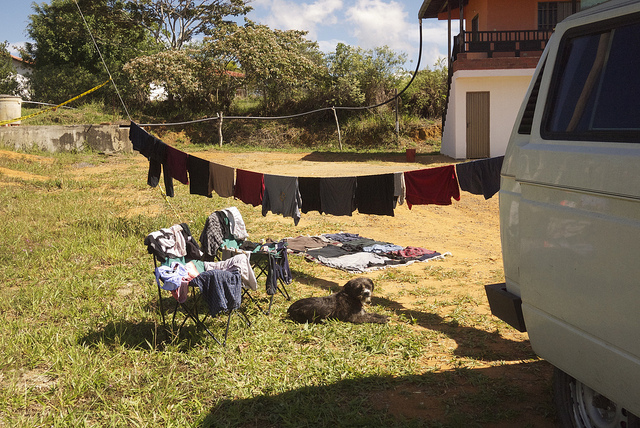Colombia continues to be very good to us, with beautiful mountains, pleasant weather, great people, and relaxed times. The agricultural strikes restricted our movement a little, but we clearly didn’t mind, hanging out in San Gil and Barichara, waiting out the strikes and our colds.

When we’d heard that the roads had been cleared, we headed over to Villa de Leyva, another gorgeous town with one of the largest squares in South America. It’s different than other squares in that it is completely barren in the center except for a fountain that is ridiculously undersized. There are no trees, no benches, nothing…just a wide open space good for marketing.

Villa de Leyva has a surprising number of formal campgrounds. One is right in the town center, and we initially set up there before realizing that the Sunday fiesta happening there would go on late into the night.

Fortunately, there were plenty of options to choose from. We wandered just outside of town to Camping San Jorge, the nicest formal campground we’ve seen since Mexico. It was the perfect place to enjoy the air, the clouds, the mountains, and even the rains, including some of the craziest thunder I’ve ever heard. Interesting Spanish language fact: there are many words to describe lightning, including “rayos” for the zig-zag lightning that breaks down to the ground, and also “relampago” for the kind that disperses in the clouds, lighting up entire sections of the sky. I love that!

Villa de Leyva was a pleasant town to walk around in–like Barichara, Milo could be off-leash and hang out with all the friendly town dogs. If it weren’t for the rigorous “schedule” we’re on (BsAs for Christmas), we probably would have camped out in Villa de Leyva for a few months. We even got to make hamburgers over the grill, twice–making up for the crappy birthday dinner I made for Juan, where I accidentally had us eat chicken prepared in ketchup, rather than tomato sauce. Things flared up on the roads again, so we happily waited. Then we hit the road for two hard days of driving to get to Medellín, a city which I’d heard wonderful things about from nearly everyone.

Well, it turned out to be something of a letdown. Entering the sprawling valley is definitely a spectacle, but coming from the crisp mountain air into the smoggy valley is a bit depressing. We couldn’t find the hotel we were looking for, so we ended up walking around for hours, finding the city to be not to be as dog-friendly as the rest of Colombia. Just when we were considering a default “splurge,” we tried our hand at one last residencia that let us in–for the steep Saturday night price of 24,000 pesos per night–about $12. It was not the worst place we’d ever stayed in, and the hot water shower compelled us to stay for two nights.

The neighborhood of La Candelaria reminded us of San Francisco’s Tenderloin–which, if you know San Francisco, is not as delicious as it sounds. It turned out to be a great stay, though, because it was right across the street from the Museo de Antioquia and the Plaza Botero. The museum opened at 10 a.m. on Sunday and we were among the first people inside. It has tons of Botero as well as many works donated by the artist from his collection of other artists, including Rodin and Max Ernst.

This morning, we had another quick cafeteria breakfast. The cafeterias impress me with their expediency. It feels like a triumph of civilization to be able to sit down and be served pastries, eggs, fried chicken, or soup for with coffee for a few dollars. I dig any culture that serves soup for breakfast. Then we drove a few kilometers south to a new hotel in a completely different part of the city, El Poblado, which must be the Medellín that everyone raves about. It feels like a different city altogether, which gigantic nightclubs and more pastry shops than cafes. Pulling into the hostel, we discovered the Jeep of our shipping partner, Evan.

Small world.

More Colombia at limpire.com
